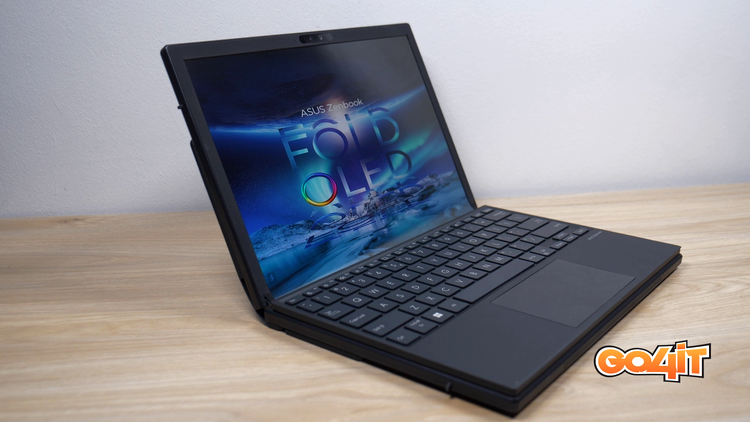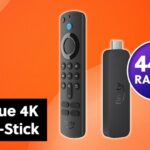It’s time for foldable screens to enter new areas, and ASUS is among the first companies to adopt the technology on laptops with the new Zenbook 17 Fold OLED. This is one part ultrabook and one part huge tablet, with a 17″ screen, Windows 11 OS and many suggested use cases. Of course, new technologies of this kind involve high research costs, and these are reflected in the market in very high prices. Here’s what a €4,000 foldable laptop can do.
Foldable form factor brings new challenges to the laptop space
I have to admit that after seeing ASUS’ presentation at IFA 2022, the Zenbook 17 Fold didn’t seem like a very attractive proposition. Sure, the huge price tag might be a deterrent for anyone in the market for a new laptop, but there were other aspects that made me unhappy before I actually saw the computer.
First, its thickness. As with foldable smartphones, the Zenbook 17 Fold suffers little from this foldable form factor. Its 17″ screen is integrated into what looks like a “tablet” format, but hides PC components inside. So even in the “open” position, it can’t be extremely thin, as it has to integrate a motherboard, a cooler and a large battery. When you fold the screen, not only does it not close completely, leaving a gap in the hinge area, but it also makes the computer twice as thick as it is in open format.
ASUS has identified this problem, and found a partial fix. Since the thickness can’t be shrunk at the moment, ASUS decided to use all the available space. So the company has developed a thin, detachable wireless keyboard that can sit between the two halves of the screen. The keyboard snaps into place with magnets, transforming the foldable computer into a largely “ordinary” one.
But there are other ways to use it, suggested by the company. You can use the Zenbook 17 Fold without the physical keyboard, just with a virtual one, for a “waterfall” screen, being able to have a web page open top to bottom, or apps up and down. The company also suggests using it in book format, but it seems to me that it’s too big and thick a device for that, and the lack of support in apps will make this mode hard to use. But probably the most useful and purpose this computer exists for is “desktop” mode, which allows use of the entire 17″ screen.
For this, ASUS has integrated a bracket on the back that allows the folding screen to be positioned vertically when fully open. The keyboard, which also includes a trackpad, can thus be positioned anywhere on the desk, or replaced with a desktop keyboard and mouse. Of course, the idea is to be able to create a large-screen mobile desktop anywhere, so the included accessory is preferable.
Being an ultrabook-based computer, I wasn’t expecting much connectivity. Thus, we have two USB-C ports, both positioned a bit oddly. In laptop mode, both jacks are in the display area, on the top right and top right, and in desktop mode, one is on top and one on the left side. There’s also a 3.5mm headphone jack, whose presence I appreciated. Also included in the package is a USB-A adapter, a USB-C charger, and even a cardboard stand to place the computer upright in portrait format. That’s because some would prefer to keep it that way, probably because of the camera, which goes to the side in landscape mode.
As expected for a €4,000 computer, the construction is carefully crafted and the materials are of high quality. We’ve got glass and eco-leather on the back, metal on the edges and a foldable screen protected with a tough plastic film. And it should be, because it’s also a touchscreen, so you’ll be touching the screen often with your finger, and it should hold up over time.
Of course, the screen has a trace in the fold area, a problem that currently no manufacturer of devices of this kind has completely solved. Fortunately, this is quite subtle and not at all noticeable in normal use when looking from the front. The only thing that might be bothersome about this wrinkle is when a light hits the screen directly and reflects in that area, or if you’re looking from the side and catch a reflection at an odd angle.
For transportation, Asus also ships this computer with a leatherette pouch, built perfectly for the Zenbook 17 Fold’s dimensions. This looks like a document bag. However, it can’t hide the fact that we’re dealing with a pretty thick computer. Of course, the foldable area is still in its infancy and involves compromises, so you gain a more portable 17″ screen than in the past at a weight of under 2 kilos, but you get a computer about twice as thick at a price about 3-4 times that of a comparable performance computer.
Zenbook 17 Fold’s hardware is similar to much cheaper ultrabooks
And here’s where the fact that for €4,000 you don’t get “all the money” performance comes into play. The price is only justified by the large foldable OLED screen. At the heart of the Zenbook 17 OLED sits an Intel Core i7-1250U processor, one of the most powerful ultraportable chips on the market, and is configured with 16GB RAM and a 1TB SSD. Of course, these components are not “upgradeable”.
Fortunately, the screen, the reason you’re paying extra for this computer, is one of the best on a laptop today. It’s built by BOE, not Samsung as we find on other ASUS laptops, but it comes with top specs like a 17.3″ diagonal, 2,560 x 1,080 pixel resolution in 4:3 aspect ratio, 500 nits of brightness, which is quite a lot for an OLED in portable form factor, and support for HDR content including Dolby Vision. Colors are factory calibrated, according to ASUS, and validated by Pantone, suggesting this computer could be used for professional work.
However, I wouldn’t go that far with this, mainly because of the performance on offer.
Performance doesn’t jump the ultraportable limits
Ultrabooks are productivity computers, for the most part, but not for the creative area, where the processing power required is high. Professional photo editing software like Photoshop or video editing software like Premiere and DaVinci Resolve require top-notch processors and dedicated graphics cards. The Zenbook 17 OLED has a 10-core processor, but only 2 of those are performance cores, 8 are “efficient”, and the graphics chip is an Intel Xe with 96 processing units, but at low frequency.
I ran a few productivity benchmarks, and the results are close to those of a regular ultrabook. Part of the problem is also that we’re dealing with a cooling system limited by the size and concessions needed to create a foldable computer. At least the cooling is quiet most of the time. When the cooler is set to “performance” mode, it is audible, but not in an annoying way.
Benchmarks
- GeekBench – Single-Core: 1,578 / Multi-Core: 6,669
- Cinebench R23 – Single-Core: 1,510 / Multi-Core: 4,863
PCMark
- Essentials – 9.661
- Productivity – 6.470
- Digital Content Creation – 4.454
- Overall – 4.681
CrystalDiskMark
- SEQ1M Q8T1 – Read: 5.990 MB/s / Write: 5.224 MB/s
- SEQ1M T1T1 – Read: 555 MB/s / Write: 3,248 MB/s
In use, the ZenBook 17 Fold offers a larger screen wherever you have room to “set up” your desk
Still, what can you do right on a computer like this? Well, pretty much what I do every day. Much of my Go4it work takes place in two windows: one for a browser and one for Microsoft Word. Occasionally I’ll open a PDF or Excel, or a simple photo editing and resizing software like XnView. I usually do this on a large-screen desktop, and when I have to switch to my personal laptop for this, which is a MacBook Air M1 with a 13″ screen, I have to change my working style a bit, since I don’t have as much screen space.
Well, with the Zenbook 17 Fold, I’ve been able to transform my mobile work experience into one closer to desktop. Sure, you can use the computer in “laptop” format, with the keyboard attached to the bottom of the screen but that way you have a smaller 12.5″ diagonal screen at your disposal, but that’s not the reason to choose a computer like this. Maybe for something quick, or on a plane and where you don’t have room on a table to fully open the computer, laptop mode might be ok, but having such a computer handy, you will always look to open it fully.
You’d think the 17″ screen would be good for watching movies and TV shows, especially when it’s Dolby Vision compatible, and the sound system is Dolby Atmos compatible, but the truth is we’re running into the same problem with foldable screens on phones: black bars all the way around. The content looks great, even above expectations, but the experience is hampered by the “dead” space around the content. And speaking of sound, for a computer with a thin body when unfolded, the audio quality and volume are above average. Given the price, that should be expected, but I’ve also encountered instances where the sound wasn’t up to par with the price.
But the 4:3 screen format has advantages in the productivity area, as it allows more space especially vertically to put two apps side by side, and to display more content, and ASUS has also developed dedicated software to control all the special functions of this computer. For example, the screen automatically turns from large to small when you plug in the magnetic keyboard. Then there are options for grouping multiple apps on the screen, and ASUS has also integrated many advanced features, such as ones that reduce the brightness of the screen when you’re not looking directly at it and increase it when you return, or that reduce the brightness of all background apps to keep a single one in focus.
All of these are also useful for protecting the OLED panel from burn-in, in addition to the classic techniques of moving pixels around from time to time or hiding the Windows taskbar. There are also features that protect the battery, such as limiting charging to a certain threshold or lowering the charging power. Unfortunately, all these functions require a MyASUS account.
There are a few lesser highlights, however, that show we’re talking about a first-generation product. Firstly, when you turn the computer on, it doesn’t know what format it’s in, so the Windows startup screen will be displayed full screen, even if you have the keyboard connected. Once you enter Windows, the display is correct. Then, the switching between keyboard and non-keyboard mode is rather unpolished, with no fluid animation or anything to hide the fact that the resolution is changing. At least it all happens very quickly and doesn’t disturb visually too much. Also, the fact that the taskbar falls right on the area where the folding takes place in laptop mode makes everything look curved in that area and hard to reach with a finger comfortably over the keyboard. Moving the border a few pixels higher would have solved the problem.
In terms of battery life, we’re still talking about a Windows computer, but one equipped with a large screen in a format that’s not very large or heavy. So even though ASUS says the battery lasts 9.5 hours, the reality is that you’ll get about 6-7 real hours of productivity. Which isn’t bad at all, but not impressive either. Of course, for that kind of performance, you need to access the most economical profile and a brightness more in the middle.
But the most annoying thing, which would also have a relatively simple fix, is that the keyboard has a separate battery and doesn’t power directly from the computer. It has to be charged separately, either with a USB-C cable from the Zenbook or the laptop charger. Worse is that it doesn’t efficiently go into standby and consumes battery even when not in use. The keyboard thus needs to be turned off every time to make sure you don’t find it out of battery power the next time you need it.
Implementing powered magnetic contacts when the keyboard is positioned on the computer, or implementing wireless charging zones on the laptop frame would have been elegant solutions to this problem. At €4,000, you can expect some more special technologies from a “futuristic” computer like the Zenbook 17 Fold. Maybe we’ll get something like this in the next generation.
Conclusions
Now that I’ve had more time to spend with the Zenbook 17Fold OLED, I have to admit that it’s a demonstration of technology that succeeds in its purpose: it brings up something new and got me thinking about the possibilities in the future. I still don’t think foldable devices are really the future of foldable devices, but I think they will help accelerate the development of the next format that might prove more practical: the rollable one.
By the time we get to rollable though, we’ll have a whole generation of foldable devices, for better or worse. The high price will probably come down over time, and those who will pay €4,000 for this model will be the ones encouraging further development of the technology. The little software glitches can be fixed even on the current generation, but I don’t know if others, such as the thickness of the devices, the screen footprint or the keyboard that charges separately, will be fixed even four years after its debut.
This is certainly not a volume product, and those who buy it will have good reason to spend such a large sum for what is basically a large-screen, foldable ultrabook.












 What’s happening with AI? Researcher explains why you can look forward to more creative NPCs, competition for ChatGPT and hot dog tomatoes
What’s happening with AI? Researcher explains why you can look forward to more creative NPCs, competition for ChatGPT and hot dog tomatoes Cowboy launches new on-demand service: That’s what’s inside
Cowboy launches new on-demand service: That’s what’s inside The new 4K Fire TV stick is now brutally reduced and transforms your old television into a smart TV
The new 4K Fire TV stick is now brutally reduced and transforms your old television into a smart TV The best mouse I’ve ever had, convinces me for gaming, work and home office and is different than all its predecessors!
The best mouse I’ve ever had, convinces me for gaming, work and home office and is different than all its predecessors! The first smart glasses suitable for everyday use that you can buy
The first smart glasses suitable for everyday use that you can buy